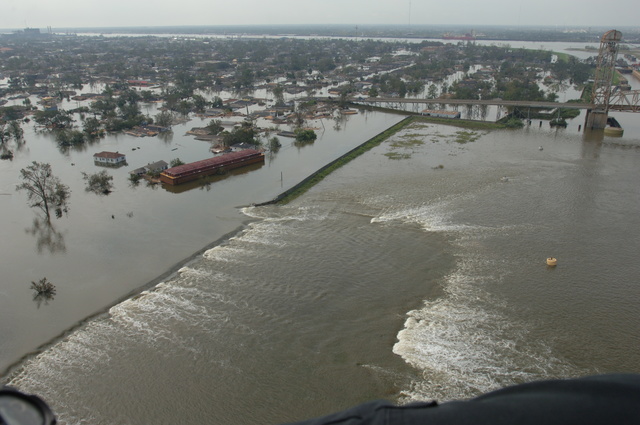Levee
|
In August 2005, Hurricane Katrina caused levees to break, releasing floodwaters into neighbourhoods in New Orleans, Louisiana. This aerial photograph shows the break in the levee in the 9th ward. Photo courtesy of Jocelyn Augustino/FEMA. |
The International Levee Handbook, published by CIRIA in 2013, defines levees as: "Raised, predominantly earth, structures (sometimes called flood defence embankments or dikes) whose primary objective is to provide protection against fluvial and coastal flood events along coasts, rivers and artificial waterways that are not reshaped under normal conditions by the action of waves and currents. Levees form part of flood defence systems that may also include flood walls, pumping stations, closure structures, natural features, etc."
As stated in the CIRIA definition (and outside of engineering applications), the terms levee and dyke are sometimes used interchangeably, but they are not technically the same.
Dykes are usually permanent structures that are built in areas that are located below sea level and are thus uninhabitable. Their placement reclaims land to make it fit for use. Levees can be permanent structures, such as those built from cement, or temporary structures which might be made from stone, earth or sandbags, and protect from flood.
There are also geographic/cultural preferences. For instance, in the state of Louisiana (which is vulnerable to flooding of rivers prompted by hurricanes), the term levee is most frequently used. In the lowlands of the Netherlands (which have been reclaimed from the sea), dyke is the common term.
See dyke.
In Ancient Egypt, levees were used along the Nile to protect the surrounding valleys and to irrigate the land. They were also used in other Ancient cultures such as Mesopotamia, where farmers built earthen levees to prevent rivers from flooding their fields.
[edit] Related articles on Designing Buildings
Featured articles and news
International Electrician Day, 10 June 2025
Celebrating the role of electrical engineers from André-Marie Amperè, today and for the future.
New guide for clients launched at Houses of Parliament
'There has never been a more important time for clients to step up and ...ask the right questions'
The impact of recycled slate tiles
Innovation across the decades.
EPC changes for existing buildings
Changes and their context as the new RdSAP methodology comes into use from 15 June.
Skills England publishes Sector skills needs assessments
Priority areas relating to the built environment highlighted and described in brief.
BSRIA HVAC Market Watch - May 2025 Edition
Heat Pump Market Outlook: Policy, Performance & Refrigerant Trends for 2025–2028.
Committing to EDI in construction with CIOB
Built Environment professional bodies deepen commitment to EDI with two new signatories: CIAT and CICES.
Government Grenfell progress report at a glance
Line by line recomendation overview, with links to more details.
An engaging and lively review of his professional life.
Sustainable heating for listed buildings
A problem that needs to be approached intelligently.
50th Golden anniversary ECA Edmundson apprentice award
Deadline for entries has been extended to Friday 27 June, so don't miss out!
CIAT at the London Festival of Architecture
Designing for Everyone: Breaking Barriers in Inclusive Architecture.
Mixed reactions to apprenticeship and skills reform 2025
A 'welcome shift' for some and a 'backwards step' for others.
Licensing construction in the UK
As the latest report and proposal to licence builders reaches Parliament.
Building Safety Alliance golden thread guidance
Extensive excel checklist of information with guidance document freely accessible.
Fair Payment Code and other payment initiatives
For fair and late payments, need to work together to add value.
Pre-planning delivery programmes and delay penalties
Proposed for housebuilders in government reform: Speeding Up Build Out.
High street health: converting a building for healthcare uses
The benefits of health centres acting as new anchor sites in the high street.

























